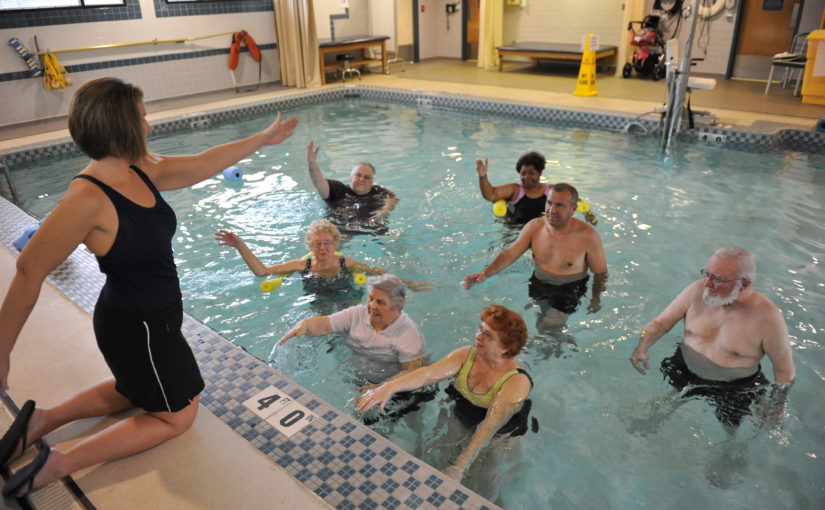Aug 26, 2020Current Trends: Supplementing Rehab with Aquatic Therapy
Every athlete wants the same thing: to spend more time working on his or her game and less time recovering. But the hard truth is that recovery is a pivotal piece of any athlete’s training program.
A growing body of research reveals that allowing for sufficient recovery between workouts is a critical component in any exercise program. Not only does it help the body recover faster, but it also allows for increases in both training volume and intensity while offsetting the risk of overtraining. While proper sleep, hydration, and nutrition are all necessary parts of the recovery process, various types of therapy are equally important.
Now, when it comes to finding the right type of therapy, there is more than one way to skin the cat. But the benefits of aquatic therapy (APT), defined as the evidence-based and skilled practice of physical therapy in an aquatic environment by a physical therapist, transcends age, and athletic ability.

According to the Aquatic Physical Therapy Section of the American Physical Therapy Association, APT includes treatment, rehabilitation, prevention, health, wellness, and fitness of the patient/client population in an aquatic environment with or without the use of assistive, adaptive, orthotic, protective, or supportive devices and equipment. Interventions for people of all ages with various disabilities, disorders, or conditions are enhanced when performed within an aquatic environment. APT interventions are designed to maintain or improve function; balance, coordination, and agility; flexibility; aerobic capacity/endurance conditioning; gait; locomotion; and body mechanics and postural stabilization.
Also, APT interventions are used for muscle strength, power, and endurance may include manual therapy, breathing strategies, electrotherapeutic modalities, therapeutic exercises, and functional training.
Some of the benefits of APT interventions include:
- Improved muscle relaxation and increased peripheral circulation through the use of warm water
- Resistance for strength training through water
- Body awareness, balance, and trunk stability stimulated by warm water.
- Through the reduction of gravitational forces in the pool, the ability to stand and begin gait training and strengthening exercises without causing further damage.
- Decreased pain sensitivity as a result of the warm water and buoyancy.
- Between-session recovery and optimal load management
It’s no wonder then, why so many professional and collegiate teams incorporate some form of aquatic therapy in its recovery programs. The Minnesota Vikings have incorporated HydroWorx’s Rejuvenate hot and cold plunge pools, as well as its underwater treadmill.
“The hydrotherapy area is probably the showpiece of our entire athletic training room,” Eric Sugarman, MS, LAT, ATC, Vice President, Sports Medicine/Head Athletic Trainer of the Vikings, said in a press release from HydroWorx.
With the use of aquatic therapy, athletes, particularly those returning from injury or surgery, have seen speedier recovery times. According to a study entitled “Benefits and Use of Aquatic Therapy During Rehabilitation After ACL Reconstruction (ACLR)” published in 2019 by the International Journal of Sports Physical Therapy, the main benefit is the ability to begin certain activities ahead of schedule.
“The main advantage of aquatic therapy in the functional recovery process is that activities or exercises can be introduced earlier in the functional recovery process than on land, potentially accelerating the recovery process and reducing the overall recovery time,” the study read. “This includes specific targeted exercises for the development or maintenance of the neuromuscular and cardiovascular (CV) systems, at a low risk of injury.”
The study goes on to suggest that to be able to effectively design the right aquatic therapy program for a post-ACLR athlete, it’s important to have a well-structured functional recovery process in place.
While there is no gold standard approach, having a criterion-based rehab with specific checkpoints to progress through the stages is regarded as the best practice. The study broadly described the functional recovery process to include four stages: (1) Early-stage rehabilitation which is focused on resolving pain and swelling, recovering sufficient knee joint range of motion, recovery of activities of daily living including the ability to walk without crutches, and minimization of muscle atrophy; (2) Mid-stage rehabilitation which is focused on restoring strength imbalances (to within 20% of the contralateral limb), basic motor patterning (e.g., functional exercises such as squat and running gait) and physical reconditioning; (3) Late-stage rehabilitation which is focused on optimizing neuromuscular and movement performance; (4) Sport-specific re-training, consisting of on-field rehabilitation, return to training and return to competition.
It is important that the aquatic therapy program is aligned to this functional recovery approach and the specific activity fit with the functional recovery stage to optimize its implementation and improved clarity amongst all members of the sports medicine/ rehabilitation team. This ideal program should always be considered as part of a functional recovery approach comprising gym-based, pool-based, and on-field rehabilitation.


